This Sourdough Starter is pretty darn easy to do and a great option for delicious homemade baked goods! A sourdough starter doesn’t have to be a chore, and the end result is worth the patience in the beginning. If you like homemade treats try my Sourdough Pretzels!
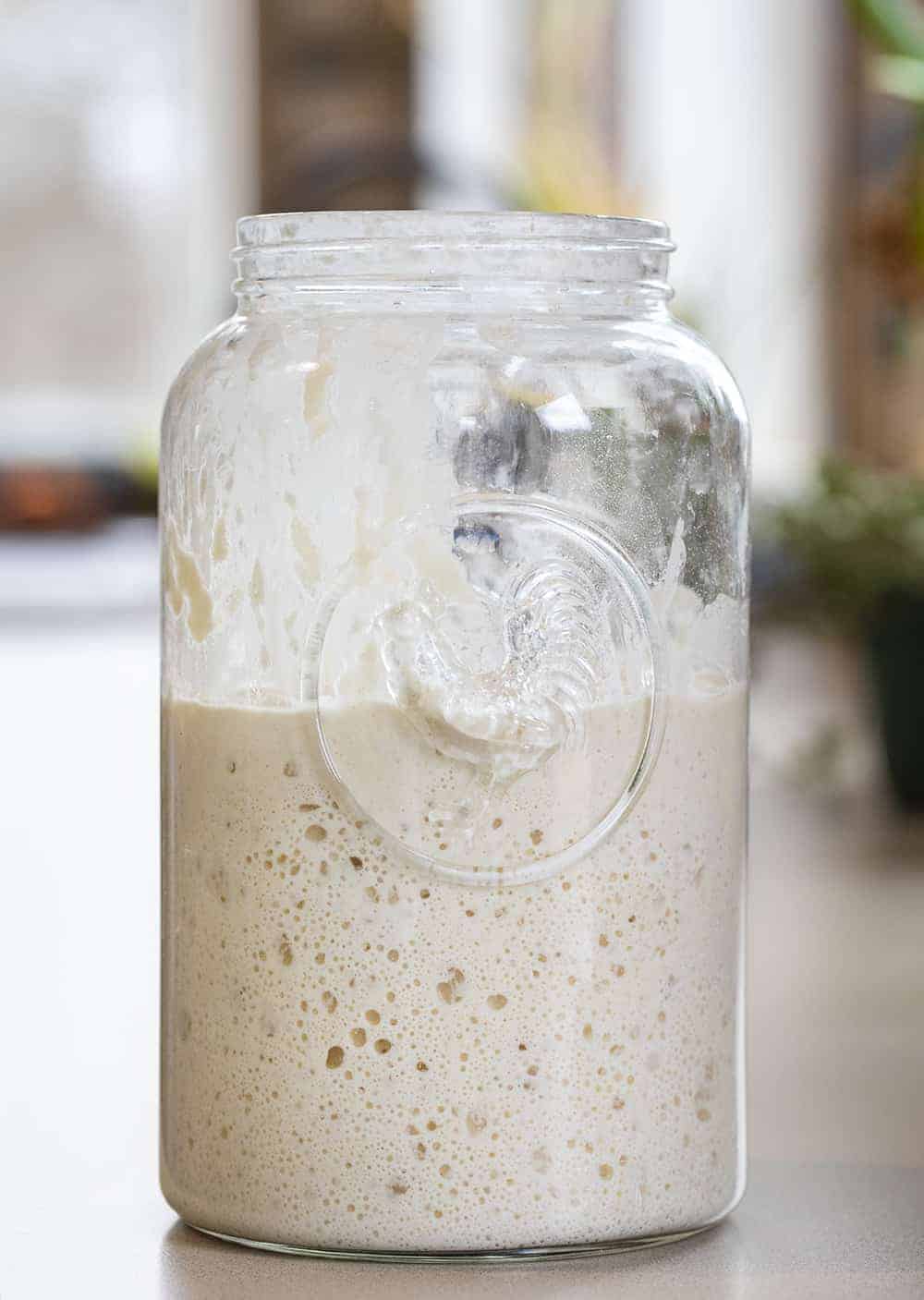
Sourdough Starter
I have to start out by saying that this is how *I* do a starter. I have watched every expert under the sun and read every book and let me tell you something… they are all different. So I have been testing and testing and retesting and using life experience to determine what works best for me. Well, I finally decided on what worked best for me, and it could not be easier and straight forward. The ingredients are simple: flour and water. And, with just two measurements to remember, the feeding is a piece of cake (or should I say bread😉) as well!

Getting your Sourdough Starter Started
Now if you want to bring science into it, the type of flour and type of water you use are important. They can produce a better product. But I am here to tell you that you can absolutely use all-purpose bleached flour from Dollar General and it will still be ok. Make sure you have the following materials and ingredients on hand:
- Jar & Lid – I prefer glass, you don’t want to use metal or plastic. If you don’t have a lid use a paper towel and rubber band. A good size jar to have on hand for a sourdough starter is a quart (32 ounces) or something close to that capacity.
- Flour – I prefer organic unbleached all-purpose, but also love whole-wheat and bread flour. Or, give rye flour a try.
- Water -Purified is best. Have chlorinated tap water (as most people do)? You can use bottled water or just set the water out uncovered for 24 hours before using it to feed your starter. This allows the chlorine to evaporate so it won’t kill the wild yeast.
That’s it for supplies! Now, let’s get to making the starter.
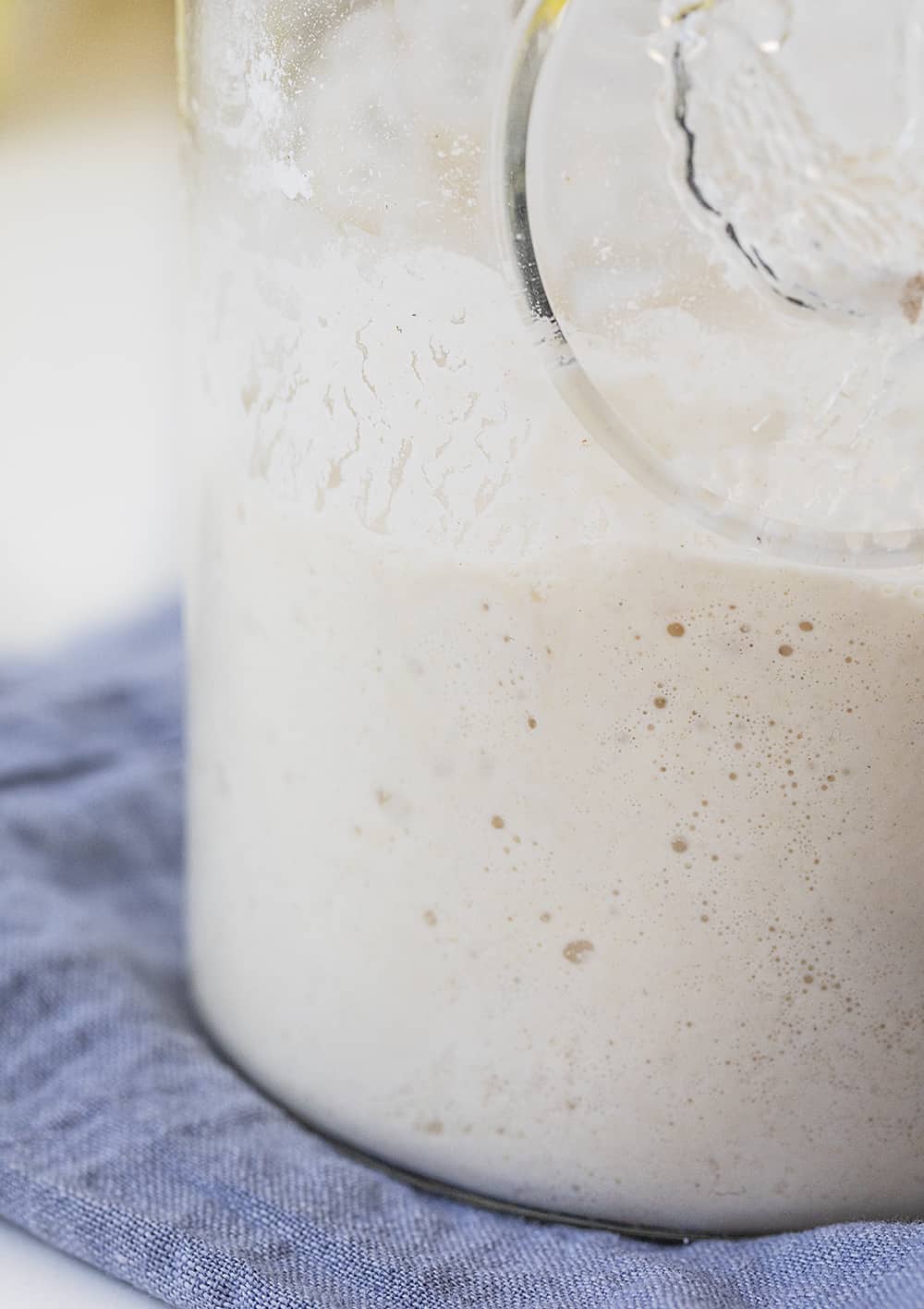
How to Make a Sourdough Starter
Remember these amounts: 1/2 cup flour and 1/4-1/3 cup water. These are the only measurements you will need to remember throughout this entire process of creating your sourdough starter. And trust me, you will use those measurements a lot with all the ‘feeding’, going on! After all, the goal is to get those microorganisms to work for that sour and fermented flavor that sourdough is known for.
To begin, add the flour and water to a jar and stir well. Try not to use a metal spoon. After all, Grandma said she always uses the handle of her wooden spoon to stir. Now gently cover the jar (do not seal it closed) and let it sit in a warm place (70°F is best) for 24 hours. The best option for a cover is a paper towel and rubber band. Or, just remember to keep the jar lid loosely sealed. Try to keep it in an area of your house that is somewhat warm. Very cool rooms tend to slow the action of a starter. Wait 24 hours before checking the mixture.

‘Feeding’ the Sourdough Starter
With sourdough starters, you will hear the term ‘feeding’. This is simply adding the flour and water to the mixture to keep the microorganisms working. Remember the measurements I told you to get ingrained in your brain? The 1/2 cup flour and 1/4-1/3 cup water is all you will need throughout the ‘feeding’ process.
Day 2: After 24 hours, check the mixture for bubbles. If you see bubbles, add the flour and the water, mixing it well, and let it sit for the next 24 hours. If you don’t see bubbles, do not get discouraged! It sometimes takes a couple of days for the science of it all to work. Just wait another day (or even two) until the first feeding.
Day 3: After another 24 hours, check for bubbles. If you do see bubbles, remove half of the starter, add the 1⁄2 cup flour and 1⁄4-1/3 cup water and stir thoroughly. Let sit 24 hours. Oh, and don’t get rid of the starter you removed! I will give you some ideas on how to use this in the end.
For the third feeding, remove half of the starter (but don’t throw it out!), and feed with 1⁄2 cup and 1⁄4 cup water, stirring thoroughly. Let sit 24 hours. (And yes, you can begin a new starter with the discard! Try adding a new kind of four! Or simply use to make crackers or pancakes.)
On days 4, 5, 6 you can feed it 2 times a day with those measurements that are sure to be memorized at this point😀. Continue this routine (discarding before feeding) until the starter is consistently bubbling and doubling in size within 8 hours of each feeding.
It is now ready to use for a perfect Sourdough Bread!
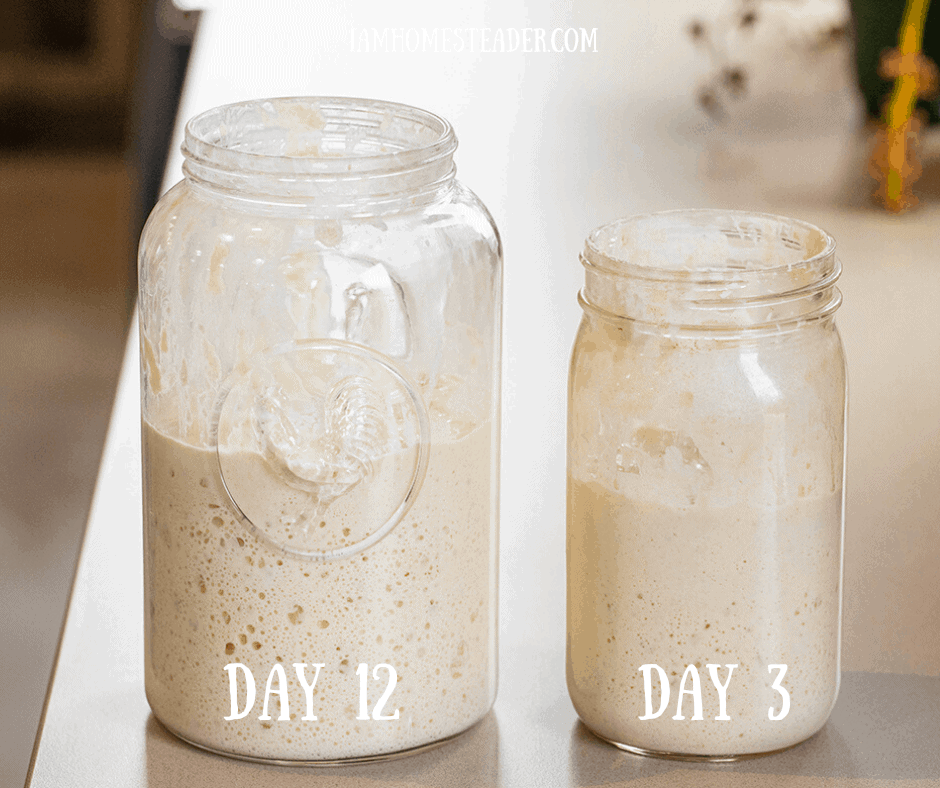
How to Store a Sourdough Starter
After all the feeding and you know you have a strong, active starter, you can store the starter in the refrigerator and feed it about once per week. When you plan to use the starter, pull it out of the refrigerator 24 hours in advance to feed it and allow it to warm up and grow.
These starters get better with age, so don’t think you have to use it right away! Sourdough starters are hearty, so they last quite a while. But, like all living things, it can get ‘sick’ or go bad. If it turns pink, red, moldy, or gets a really putrid smell, throw it out. After all, you now know how to start again!
What Flours Can You Use in a Sourdough Starter?
All grain-based flours will work beautifully in a starter. A few examples are:
- Rye
- Bread Flour
- Rice
- Whole Wheat
- Einkorn
Truesourdough.com has a great comprehensive guide to flours.
Vanilla and Bean has a great guide to Gluten-Free sourdough starter.
What to do with the Discard?
As I said, don’t throw out the sourdough starter that you remove each feeding time to make room for the starter to rise. Just make sure your sourdough starter is room temperature (about 70°F) before using it in baking. Here are some ideas on how to use (and enjoy) the excess sourdough starter.
- Sourdough Bread (not until day 6 or 7)
- Sourdough Pancakes (seriously SO GOOD!)
- Sourdough English Muffins
- Sourdough Brownies
- Sourdough Pretzels
- Cinnamon Rolls (the best!)
- Banana Bread
- Sourdough Crackers (like saltines)
- Sourdough Chocolate Chip Cookies
- Sourdough Pasta Noodles
As I mentioned, this is how *I* make a starter. King Arthur recommends 1 cup flour and 1/2 cup water and they suggest you weigh ingredients with a scale. (This is the same equivalent that I use, just doubled.) Pro Home Cooks has a great free downloadable Sourdough guide for those who really want to understand the science behind it.
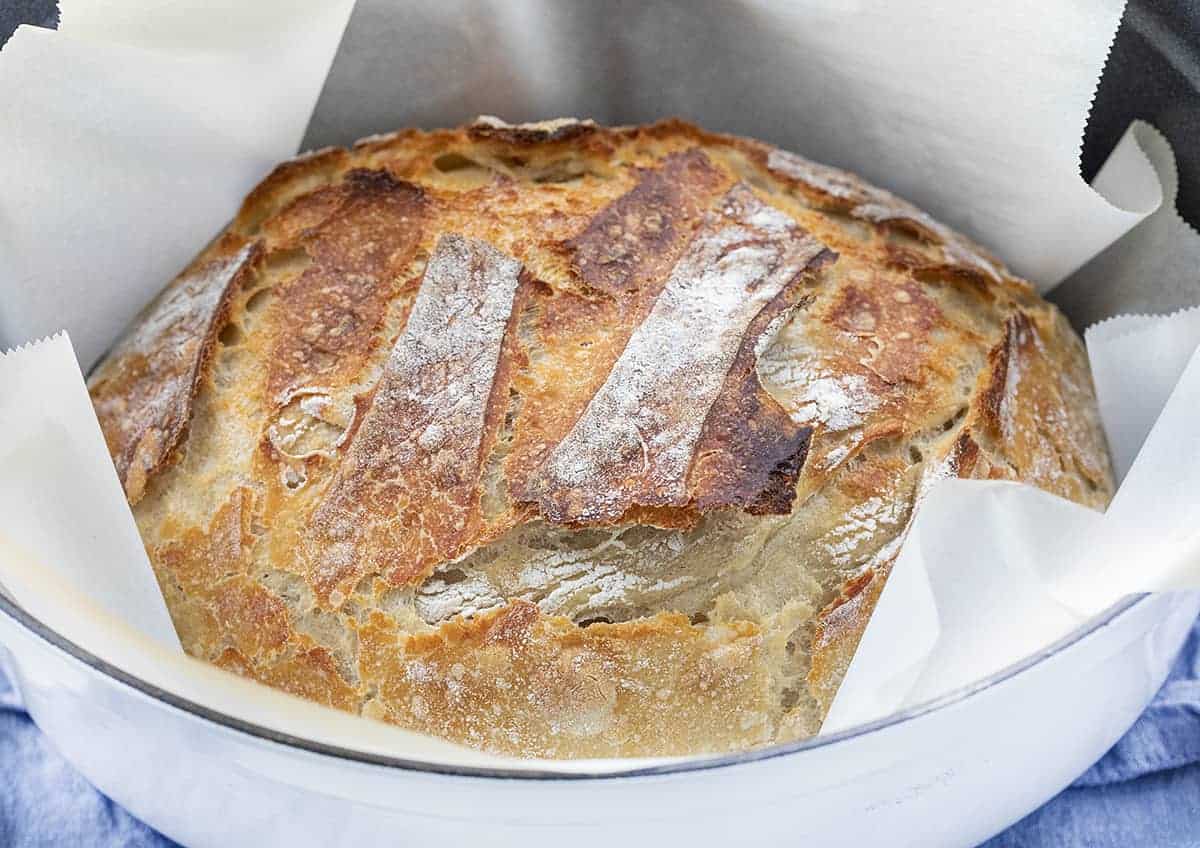
Here is the recipe for Simple Sourdough Bread!
More Sourdough Recipes

Sourdough Starter
Ingredients
- ½ cup flour, whole wheat or unbleached all-purpose
- ¼-⅓ cup water*, 75°F is ideal
- 1 glass jar, or bowl (about 32 ounces)
- 1 paper towel
- 1 rubber band
Instructions
TO BEGIN
- Start the process by adding ½ cup whole wheat flour and ¼ cup water to the jar. (If you need more flour to reach a pancake batter consistency, you can add up to ¼ cup more.)
THE FIRST FEEDING
- Stir thoroughly and cover with a towel and rubber band. Let sit for 24 hours at room temperature. (Try to keep it in an area of your house that is somewhat warm. Very cool rooms tend to slow the action of a starter.)
- After 24 hours, check the mixture for bubbles. If you see some, add ½ cup all-purpose flour and ¼-⅓cup water. If you don’t see bubbles, give it a stir and let sit 24 more hours.
THE SECOND FEEDING
- Check for bubbles again. If you do see bubbles, remove half of the starter, add ½ cup all-purpose flour and ¼-⅓ cup water and stir thoroughly. Let sit 24 hours.
THE THIRD FEEDING
- Remove half of the starter, and feed with ½ cup all-purpose flour and ¼ cup water, stirring thoroughly. Let sit 24 hours.
ADDITIONAL FEEDINGS
- On days 4, 5, 6 you can feed it 2 times a day, if you want and plan on using it.
- Continue this routine until the starter is consistently bubbling and doubling in size within 8 hours of each feeding.
- From this point (or even on day 5), you can store the starter in the refrigerator and feed it about once per week. When you plan to use the starter, pull it out of the refrigerator 24 hours in advance to feed it and allow it to warm up and grow.
Video
Notes
Did you make this recipe?
You can tag me at @iamhomesteader.
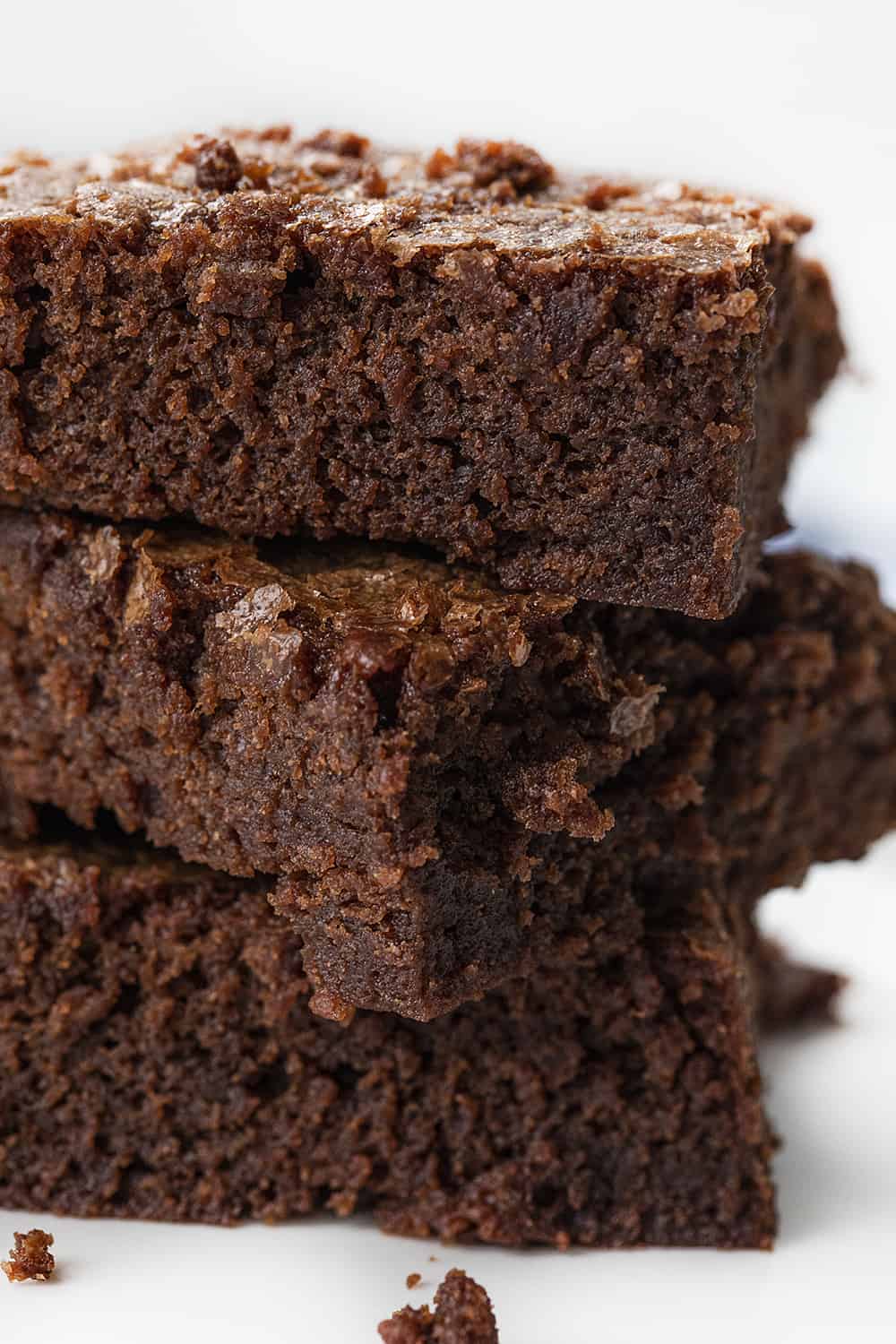
I used this starter to make seriously decadent Chocolate Sourdough Brownies!

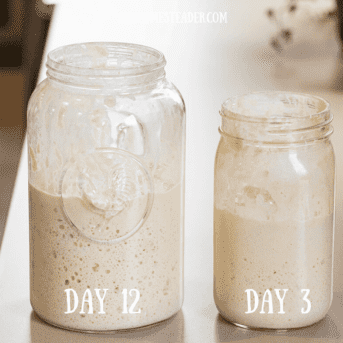
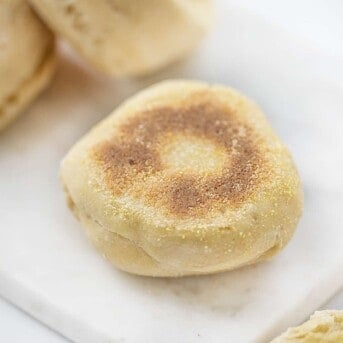
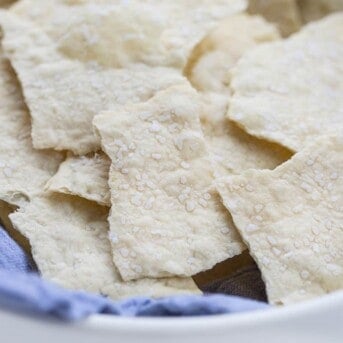




Is it okay for it to be stored in a dark place for with no light or is it recommended to store In well lit area? Which would be best? Thanks!
You can store your sourdough starter at room temperature not in direct sunlight if you bake with it frequently, or in the refrigerator if you bake with it less often. Room temperature storage requires more frequent feedings but leads to a more active starter and faster bakes. Refrigeration requires less maintenance but takes longer to activate the starter and may result in slower bakes.
Your recipe starts with half cup and a quarter cup water which should make a pancake consistency and then you recommend adding flour assuming because it’s too watery but with that ratio mine starts out with a super thick dough so I’m having to add water not flour. Is it because I’m using rye flour instead of all purpose and are we aiming for the pancake consistency, regardless of the ratio?
It sounds like you’re encountering a consistency issue with your sourdough starter, and you’re using rye flour instead of all-purpose flour. Let’s address your concerns:
Consistency: The consistency of the starter can vary based on factors like the type of flour used, temperature, and hydration levels. It’s okay if yours turns out thicker or thinner initially. The most important thing is to maintain a consistency that allows for fermentation and the development of bubbles. (I want to stress that this is the most important part!)
Flour Choice: Rye flour tends to absorb more water than all-purpose flour, which could explain why your starter is thicker. It’s not uncommon for starters made with different types of flour to have varying consistencies. Since you’re using rye flour, it may require slightly more water to achieve the desired consistency compared to all-purpose flour.
Based on your situation, it’s perfectly fine to adjust the water or flour amounts to achieve a consistency that works best for your starter.
Do you keep adding your discard to your previous discard? And store it in the refrigerator until want to use it? I read that you should throw it way for first 7 days because it contains bad bacteria that could get you sick. Confused and totally a beginner here
As a beginner with sourdough, it’s understandable to have questions about what to do with the discard! Here are some options:
Storing discard: Yes, you can store your discard in the refrigerator until you’re ready to use it or until you decide what to do with it. Keeping it in the fridge slows down the fermentation process, which can be helpful if you’re not planning to use it immediately.
Adding discard to previous discard: You have a couple of options here. You can either add your new discard to your existing discard in the same container, layering them on top of each other, or you can store each day’s discard separately in the fridge until you accumulate enough to use in a recipe. Both methods are common among sourdough enthusiasts.
Discarding for the first 7 days: This advice might come from a cautionary perspective, as in the initial stages of cultivating a sourdough starter, there can be a higher chance of undesirable bacteria proliferating before the beneficial lactobacilli and yeast take over. However, with proper feeding and care, the risk of harmful bacteria is minimal. Many sourdough bakers use their discard from the beginning without any issues. If you’re concerned about safety, you can discard the first few days’ worth of starter until it becomes more established and active.
Ultimately, the decision of what to do with your discard is up to you. Some people use it in recipes like pancakes, waffles, crackers, or even discard bread, while others simply discard it. It’s a matter of personal preference and what fits best with your baking routine. As you continue on your sourdough journey, you’ll find what works best for you. Don’t hesitate to experiment and enjoy the process!
Hi
I’m very new to this…. I’m on day 5 just doing one feeding. I discard and feed. It has not doubled in size except for once on day 2 ( then exhausted itself I think) there are bubbles each morning and today a little “hooch” which I took off. Should it be further along at this point? .
My house is cooler so I’ve placed in oven with the light on. I’m storing my discard in the fridge because I’m not brave enough to do another starter at the same time 😊. I feed with 1/2 cup flour 1/3 cup water. Just keep doing the same ? Or should I start feeding 2x a day? Thank you 🙏
It sounds like you’re doing a great job with your sourdough starter journey! Since your house is cooler, placing it in the oven with the light on is a smart move to provide a slightly warmer environment for fermentation.
Seeing bubbles is a positive sign, and the appearance of “hooch” indicates that your starter is active. The fact that it doubled in size on day 2 is a good sign, even if it then subsided.
At this point, it’s normal for the starter’s activity to vary. If it’s not consistently doubling in size within 8 hours of feeding, it may benefit from more frequent feedings. Since you’re on day 5, you could try feeding it twice a day to see if that helps kickstart its activity. Keeping the discard in the fridge is a good idea, especially if you’re not ready to start another starter yet.
Continue with your current routine for a few more days and monitor the starter’s progress. If you notice it’s not becoming more active or if it seems sluggish, then transitioning to twice-daily feedings might be worth a try. Trust your observations and adjustments, and remember that sourdough can be a bit finicky but rewarding in the end! Keep up the good work, and feel free to reach out if you have any more questions along the way.
I started my sourdough starter on Monday and let it set 24 hours into yesterday and it had bubbles so I fed it for the first time and let it sit. My starter doubled in size 6.5 hours after that first feeding. I let it sit for 18 hours into this morning and it deflated (which I read is normal cause it’ll peak and then get “exhausted”), but this morning when I checked on it… it smelled like vomit, super sour. I read that that can be normal. I just removed half of it and fed it for the second time even though it hasn’t been 24 hours. Is it normal for it to smell like that and is it still okay? Should I be feeding it and removing half of it once it doubles in size in 8 hours after feeding even though I’ve only started it on Monday?
It’s great to hear that your sourdough starter is showing signs of activity! The process you described is indeed normal for a developing sourdough starter.
The sour smell you’re experiencing is quite common during the early stages of sourdough fermentation. It’s caused by the production of acidic compounds by the naturally occurring bacteria and yeast in the starter. This is an essential part of the fermentation process and indicates that your starter is active and working as it should.
As for the feeding schedule, it’s generally recommended to maintain a consistent feeding routine to keep your starter healthy and active. While it’s not uncommon for a starter to double in size within 6-8 hours after feeding, especially during warmer temperatures or if your starter is particularly active, it’s not necessary to feed it more frequently than every 24 hours at this stage. However, if your starter is doubling in size rapidly and then deflating significantly before the next feeding, you may want to adjust the feeding ratio or timing to better accommodate its activity level.
Discarding before each feeding helps regulate its growth and maintain a balanced microbial environment. This prevents the starter from becoming overly acidic or developing off-flavors. It’s perfectly fine to discard and feed your starter based on its activity level rather than strictly adhering to a 24-hour schedule, especially during the initial stages of development when it may be more active.
It’s normal for your sourdough starter to develop a sour smell and show fluctuations in activity during the early stages of fermentation. As long as it’s doubling in size, showing bubbles, and maintaining a healthy appearance, it’s likely on the right track. Keep up with regular feedings, adjust the feeding schedule if necessary based on its activity level, and continue monitoring its progress. With time and consistent care, your sourdough starter will become stronger and more predictable in its behavior.
What happens if I didn’t discard on day two but added the feed. What’s do I do
If you didn’t discard any of your sourdough starter on day two but added the feed, don’t worry too much. While discarding a portion of the starter before each feeding helps regulate its growth and maintain a balanced microbial environment, skipping this step occasionally is unlikely to cause any major issues, especially early on in the starter’s development.
I’m on day 3, everything is looking great, after day 6 how do I make bread? I’m so new to this 😂🤦🏽♀️
Great! Here is a sourdough bread recipe
https://iambaker.net/simple-sourdough-bread/
and here are many more recipes using your sourdough, in addition to the ones listed above:
https://iambaker.net/#search/q=sourdough
Hi! I just wanted to double check that I can keep my discard in a jar at room temp or do I need to keep it in the fridge? Thanks so much!
Yes, you can leave it at room temp! If you don’t plan on feeding it you can refrigerate.
Day one. So excited, thank you for such easy advice!!
When you put it in the fridge, do you still just use a paper towel covering or do you close the lid all the way?
Your starter is alive and needs to breathe a little bit. A lid is fine, so long as it’s not completely air-tight.
I accidentally doubled the amount of starter. I used 1cup flour and 1/2 cup water. Should I continue with that or can I use the 1/2 cup flour and 1/3 cup water when I discard. I just started this today. Thank you for your help, this is my first attempt at starter.
Don’t worry, mistakes happen! Since you accidentally doubled the starter, you can adjust by using the 1/2 cup flour and 1/3 cup water when you discard. It should help balance things out. Just continue with the adjusted measurements, and your starter should progress just fine. Good luck with your first sourdough starter, and feel free to ask if you have any more questions along the way!
Can the starter be done in a zip lock bag-like Amish friends bread?
Thanks for your question! While it’s not the traditional method, you can experiment with creating a sourdough starter in a zip lock bag similar to Amish friendship bread.
Please keep in mind that using a jar or container with a lid allows for better airflow control and observation.
If you try it just remember to burp the bag to release any built-up gases and keep a close eye on the starter’s progress.
I have 2 questions:
1) My discard is in the refrigerator I am on Day#4 and plan on continuing to add my daily discards. Can they go in the same jar and should I mix them together?
2) When feeding the discard weekly, do I add the same amount of flour and water as before and do I pull it out of the refrigerator, feed it, and replace it?
Thanks! Melissa
Hi Melissa!
1. Regarding your daily discards in the refrigerator on Day #4, you can mix them together in the same jar. Just continue adding your daily discards to the existing discard in the same container. This helps build up a concentrated and well-developed starter. Make sure to stir it thoroughly when adding the daily discard.
2. When feeding the discard weekly from the refrigerator, you should add the same amounts of flour and water as before, which is 1/2 cup of flour and 1/4-1/3 cup of water. You should indeed pull it out of the refrigerator, feed it, and allow it to sit at room temperature for a few hours (around 70°F or 21°C) to reactivate and grow before placing it back in the refrigerator. This weekly feeding helps maintain the health and vigor of your sourdough starter.
If you have any more questions or need further clarification, feel free to ask!
My starter is rising on first day the top doesn’t look right to me I’m sorry hell I’m Melissa I’m new to it all and I picked ur recipe to use
What doesn’t look right about it?
Hi! Day 1 no bubbles- no feed. Day 2 bubbles- feed. No bubbles now going on day 4… What have I done? Wooden spoons, glass jar, purified water… Sure smells like it’s working but all I’ve got is hooch.
Hello there! It’s great that you’re giving sourdough a try! Let’s take a look at your sourdough starter journey:
Day 1 – No Bubbles, No Feed: Don’t worry if you didn’t see any bubbles on the first day. That’s pretty normal, and there’s no need to feed it just yet.
Day 2 – Bubbles, Feed: Seeing bubbles on the second day is a positive sign. You did the right thing by feeding it at this point.
No Bubbles on Day 4: If there are still no bubbles on day 4, don’t panic! Sometimes, it takes a little longer for the magic to happen. It could be due to factors like temperature or the type of flour you’re using.
Temperature: Make sure your starter is in a cozy, warm spot, as cooler temperatures can slow things down.
Flour: Consider switching to unbleached all-purpose flour, which tends to work well for most starters.
Hooch Formation: The mention of “hooch” indicates that some liquid has separated on top of your starter. No worries, this is a sign of activity! Just pour off the hooch and then give your starter a good feeding.
Patience and Consistency: Remember, sourdough starters have their own timing. Be patient and stick to your regular feeding routine. Keep an eye on your starter for any signs of activity.
With a little more time and tender loving care, your sourdough starter will come to life and be ready for some delicious sourdough baking adventures!
So I am almost a week into making a starter. I started storing it in the oven with the light on and finally I am starting to see better result. My question is, is this safe and ok? Mold wise I dont see any. Also, how soon can I bake with the discard?
It’s great to hear that you’re making progress with your sourdough starter! Storing it in the oven with the light on can provide a slightly warmer environment, which can help promote yeast activity. As long as you don’t actually turn the oven on, it should be safe.
Regarding using the discard, you can start using it for baking when your starter is consistently active and doubling in size within 8 hours of each feeding. This typically takes about a week or more, so you might be getting close. To be sure, you can perform a ‘float test’ by dropping a small spoonful of the discard into a glass of water. If it floats, it’s ready to be used in recipes.
Remember to keep a portion of your starter for ongoing use and feeding, and you can use the discard in various recipes like pancakes, waffles, or even discard-specific recipes like discard crackers or discard muffins. (alot of those recipes are linked right in the post above!) Enjoy your sourdough baking!
Thanks for the advise! It’s definitely doubling in size within about 4 hours since moving it to my oven for a more consistent temp. Do I keep feeding it twice a day now that it’s definitely doubling quickly? Sorry if these are by silly repetitive questions. This is all new to me!
Thank you!
Can you start another starter with the portion of removed starter when feeding? Like out that removed portion into it’s own jar and start another starter?
Absolutely! I do that often. 🙂
How much starter do you discard in measurements?
I specified that you will remove half. This will vary depending on how active your starter is and how much it has risen, so there is no way I can give you an exact measured amount to remove.
I am just starting out baking with the starter and my husband is diabetic I have recipes that I already use like pancakes for diabetics can I just add the starter to my recipe Will that work
thank you
Marilyn Kemp
I have a bunch of sourdough recipes, savory and sweet! You will be able to use your starter in all of these.
https://iamhomesteader.com/#search/q=sourdough
https://iambaker.net/#search/q=sourdough
My starter was doing so good, I had 3 jars, one on day 7, one on day 5, and one on day 4, and I forgot to feed them for 36 hours and checked them today and they were all horribly molded, what happened? They were doing so amazing. Is it because I forgot to feed them? I want to try this recipe again but I’m worried about making the same mistake. Advice??
Hi there! It’s unfortunate that your sourdough starter went moldy after such a promising start.
Mold growth in a sourdough starter can be attributed to a few factors, and it’s not necessarily solely because you forgot to feed it for 36 hours. Here are some considerations:
Hygiene: Ensure that the jar or container you’re using is thoroughly clean and dry before you begin. Any residual moisture can promote mold growth.
Temperature: Sourdough starters thrive in a warm and stable environment. Very cool or fluctuating temperatures can slow down the fermentation process and make your starter more susceptible to mold.
Feeding Schedule: While it’s important to maintain a regular feeding schedule, sourdough starters can be quite forgiving. Missing one or two feedings shouldn’t lead to mold if the starter is otherwise healthy.
Flour: Use high-quality, unbleached flour. Sometimes, low-quality flours can introduce unwanted contaminants.
Aeration: Stirring the starter and introducing oxygen during feedings can help prevent mold growth. It’s a good practice to give your starter a good stir before feeding it.
Moving forward, here’s some advice:
Start Fresh: Unfortunately, once mold sets in, it’s best to discard the contaminated starters. Begin with a new batch of flour and water.
Maintain Consistency: Stick to a regular feeding schedule and try to keep the environment stable and moderately warm.
Pay Attention: Observe your starter for any unusual odors or colors. If you notice anything off, take action promptly.
Patience: Sourdough starters can take some time to become robust. It’s normal for them to go through phases of activity and inactivity. Be patient and persistent.
Consider Storing in the Fridge: Once your starter is established and active, you can store it in the refrigerator between feedings. This reduces the need for daily maintenance.
Remember, sourdough starters are living organisms, and with some care and attention, you’ll likely have success in cultivating a healthy one. Don’t be discouraged by this setback, and feel free to ask if you have any more questions or need further guidance!